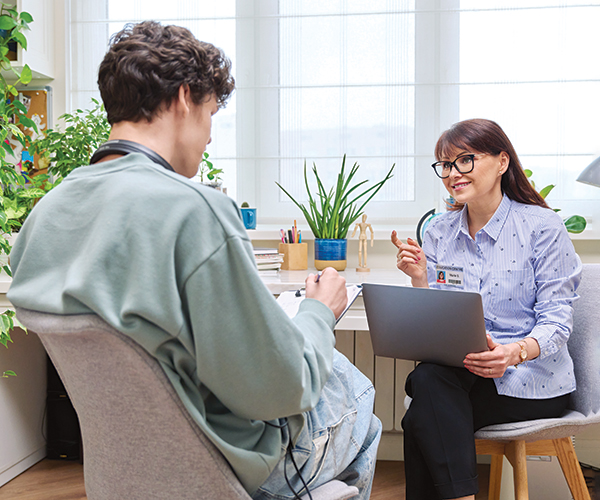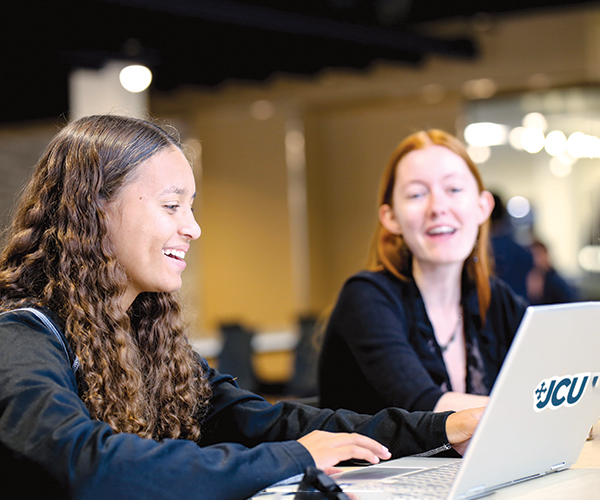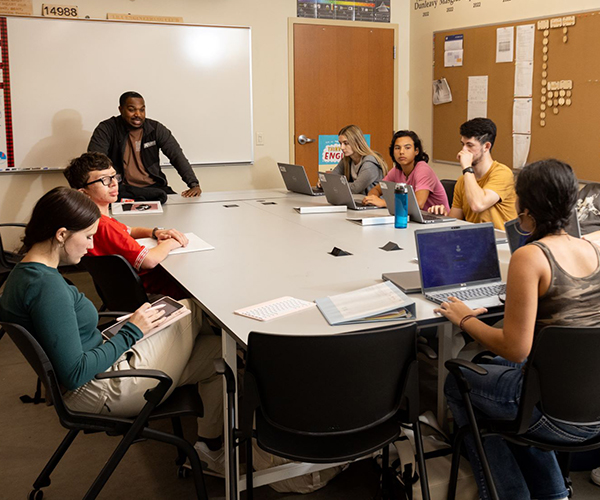How Schools Are Helping Students Fight Anxiety
by Kristen Hampshire | Oct. 10, 2019 | 12:00 PM
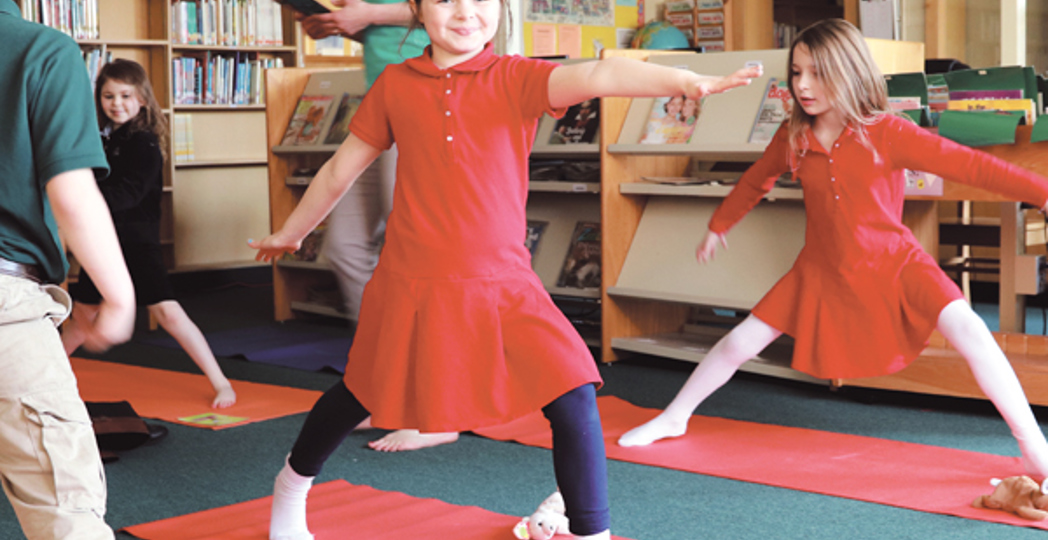
Beaumont School’s annual October Wellness Day gives high school girls a menu of mini classes to experience during an October Friday that’s dedicated to “me time.” From playing board games, writing in a journal or learning to meditate, to practicing yoga and working with clay, the lineup of activities is meant to let the students wind down.
“Life can get pretty hectic,” relates Amanda Desamito, a 17-year-old senior at Beaumont. “I always try to give the best of myself, and there are times when I stretch myself too thin, or I feel like I’m falling short. I’m the type of person who never wants to disappoint anyone.”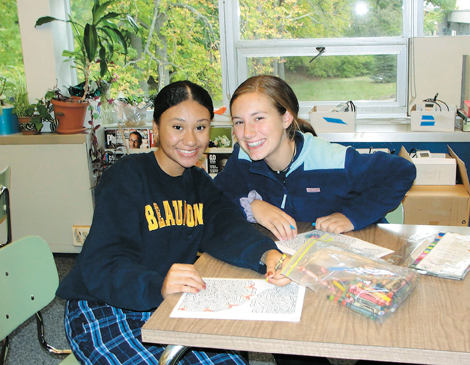
Desamito filled her Wellness Day last year with sessions including ceramics and a class where students enjoyed coloring while listening to calming music.
But her favorite is journaling.
“By writing down what I’m feeling, I can get it out of my head so I can move past it,” Desamito says. “Once I write it down, I physically get rid of the paper, so I don’t let it bother me anymore.”
When she feels overwhelmed throughout the year, she recreates a Wellness Day moment by writing or simply taking a break.
“At Wellness Day, I learned more about myself,” Desamito says. “You leave with a positive attitude.”
During Wellness Day, Abigail Miklowski, a 16-year-old junior at Beaumont, made a calming jar she can shake up and watch as a way to exhale. Now, she keeps one on hand.
“It’s relaxing to watch all the glitter and particles inside slowly fall to the bottom, and it reminds me to take a break,” she says.
Students face increasing pressure in today’s environment, where they’re exposed to more content — online and in real time. They confront a great deal of competition with testing, college applications and even financial worries. Their schedules are packed with sports, clubs and other resume-building activities. And then there’s social media.
“You leave a digital footprint wherever you go, and that adds pressure,” acknowledges Alicia McLean, director of guidance at Beaumont.
Anxiety and depression are on the rise in teens, and elementary school teachers are finding even the youngest students are overwhelmed, too. Seventy percent of teens say anxiety and depression are a major problem among peers, according to a 2019 Pew Research Center study. An additional 26% say it’s a minor problem.
What’s driving these mental health conditions to the school stage? Based on the Pew study, academic pressures top the list, with 61% of teen respondents agreeing this is an issue — followed by appearance (29%) and the pressure to fit in socially (28%).
But Tom Carey, who has been counseling boys at St. Edward High School for 16 years, says awareness of mental health is also on the rise.
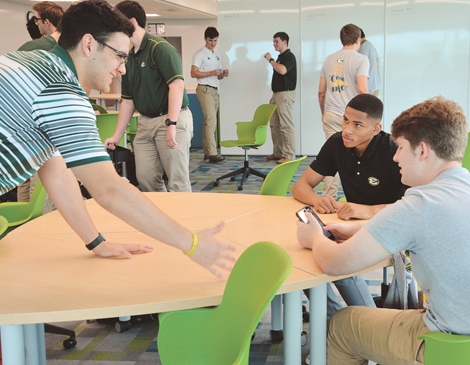
“I definitely see an increase in anxiety and the stress levels of students,” he says. “Students are more willing to talk about it.”
While some parents may wonder if attending a co-ed versus an all-girls or all-boys school changes the anxiety picture, the jury’s out. Carey, who spent a couple of years teaching in a co-ed school, says the stress isn’t greater or lesser. “It’s just about different things,” he says.
But no matter the casues of the stress and anxiety, schools are responding with initiatives like integrating wellness activities into the day, offering advisory groups, carving blocks of time for students to reset and providing parent education.
Take Beaumont’s Wellness Day.
“It’s a day to say, ‘We see you. We see how hard you work. We see what you carry on your shoulders,’ ” McLean relates. “ ‘Let’s relax and have some fun while finding new ways to address concerns. Let’s promote and celebrate wellness.’ ”
Even providing a bit of leeway can go a long way toward easing stress. Katie Bagley, a 17-year-old senior at Beaumont, says sometimes teachers will re-arrange tests so students aren’t stuck studying for several major exams at once.
“That little stuff supports us in our endeavors,” she says. “Honestly, I think it makes us more successful.”
Block Letters
Each fall, Gilmour Academy surveys its seventh through 12th graders after the school year falls into a rhythm and workloads tend to ramp up. The purpose is to gauge students’ stress levels and find out what issues are contributing to anxiety.
The school’s staff and faculty realized a couple of things based on student feedback and their own observations. First, students were piling extra activities onto the schedules because they have such varied interests. Second, because of after-school sports and academics, some students found attending clubs difficult because there just wasn’t enough time after school.
Homework loads, on top of all the extras, added up to late nights and additional stress and anxiety for many students, so the school is trying something new.
This year, Gilmour introduced a 90-minute community block to its daily class schedule, which consists of three 30-minute modules that students have the flexibility to use for attending clubs, meeting with teachers, doing homework or simply socializing with friends.
“Some kids just need to take a break,” says Meagan Fowler, Gilmour’s director of student support services.
So far, the community block time is resonating with students. “I’ve overheard them in the hallway saying that it provides a huge sense of relief knowing they can see teachers or get a little extra homework done without staying up until midnight,” Fowler says.
The gym is open during this time, so students can run around and play for a while. They can attend a yoga class.
“Some kids just need time to relax and talk to friends,” Fowler says. “And that helps them regulate their emotions better.”
The hope is that this flexible time will encourage students to learn when to take breaks — a skill they’ll need throughout life.
In the lower school, for students in kindergarten through sixth grades, 15 minutes of wellness is built into every morning. The school addresses social-emotional issues, stress reduction and provides outlets for getting the wiggles out, too.
“We are trying to instill this even in our babies, because as they grow older, they need to have the skills to cope,” Fowler says.
Support Group
At Lawrence School, students start each day by meeting with a small advisory group made up of a teacher and small cohort of fellow students, and that time is spent setting up for the day: reviewing the schedule, talking through concerns, problem-solving and just listening.
“It’s a very calming way to begin the day,” says Christina Wooley, whose daughter Francine attends the school. “The students don’t just race into everything. The advisers can assess the energy and meet kids where they are.”
The same meeting happens at the end of the school day, providing closure and organizing students so they can head home feeling empowered and ready for whatever’s next. Wooley says these organizational strategies have calmed her daughter’s anxieties compared to her previous school experiences.
“My daughter used to carry every book home in her backpack,” she says. “It looked like a semi-truck because she was so worried that she would forget something. Now, she checks her planner and reviews it with her adviser, and she gets set up for homework and what she needs to get done for the next day.”
Having a plan in place provides peace of mind for many students, acknowledges Shanika Lovelace, director of high school at Lawrence School. That’s why the school equips a Learning Resource Center with academic support and tools, a full-time counselor dealing only with mental health concerns, a school psychologist and a college and career planning department.
“It’s a one-stop shop,” she says, noting that a personalized approach to helping students and families plan for what’s next after high school can alleviate stress. “The process of getting a student from high school to college or whatever is next is daunting.”
Lovelace says that 100% of Lawrence students graduate with a plan for the future.
“They know where they are going and what they are going to do, and having someone walk you through that is important,” she says.
At St. Ed, reducing anxiety begins with Night at the Nest, a sleepover event for incoming freshmen, which allows them to explore campus with their new classmates. They move through different activities staged throughout the school, so they get to know the lay of the land. And, they meet faculty and begin growing relationships with peers, including older students.
“We have a bunch of different challenges around the school, varying from trying to solve a Rubik’s Cube in under a minute to trying to kick a field goal,” says Colin Ashdown, a 15-year-old freshman. “The upperclassman showed us some of the cheers and chants they do.”
Night at the Nest gave Ashdown and his peers an increased level of comfort before starting their first day at St. Ed. “Once I got there, I knew the faces of the people I saw that night, and it made it easier in the hallways and at lunch because you have new friends to talk to,” he says.
During the orientation event, Ashdown says he pushed himself to talk to people he didn’t already know from his middle school or from sports. “I wanted to expand,” he says, adding that getting to know new people wasn’t hard at the event because they were all in the same shoes.
Since the school began Night at the Nest 10 years ago, Carey has noticed a greater comfort level among incoming freshmen. “This makes a huge difference in reducing the anxiety involved with coming to a new school,” he says. “We are trying to make that transition smooth.”
The key is to build relationships at school, so students feel safe and connected, and so they know who to tap if they are struggling.
Like Lawrence, St. Ed also does this through advisory groups. The school gives students a “trusted adult survey” and asks them to identify any adult in the building — a teacher, counselor, coach, staff member. The school shares these contacts with parents, so they have a point person to reach out to aside from counselors.
“We want to make sure no student falls through the cracks,” Carey says.
Social Media’s Toll
Social media adds a new dimension to students’ lives that didn’t exist when their parents were in school.
“The issues that any typical teenager is exposed to is more in their faces because of social media,” Fowler points out.
For Nyomi Morris, a 17-year-old senior at Beaumont, social media, even in small doses, can have a lasting effect.
“When you have a minute to go online, and that minute is filled with the perfect days of everyone else while you are having a regular one or a not-so-great one, you can feel like you are the only person stressing out about things,” she says.
Morris reminds herself that social media tends to show the best side, and that there are other ways to unwind rather than scrolling. For instance, during the school’s Wellness Day, she chose to have fun and played card games and did puzzles.
Indeed, social media is a real factor in the anxiety and depression that students face in their lives. Cellphones are now a part of how they communicate, Lovelace says. And, there is a more lasting impact to the conversations that happen online.
“Students are held to higher standards,” she says. “It’s personal. It’s out there. There are fewer chances for kids to mess up, so the stakes are higher.” Wooley reminds her kids that everyone is working on something in their lives, emphasizing that they should focus on themselves and not others.
“This creates a sense of, What do you need right now, and how do we continue to grow you?” she relates.
Students need to learn how to appropriately use cellphones and engage on social media because it’s part of life. Teachers, parents and administrators can use this as a teaching opportunity.
“Students are using phones instead of face-to-face,” Lovelace says. “And we are educating them on how to socialize properly using their phone.”
Treat a cellphone or social media account like other major milestones in a kid’s life, Lovelace advises.
“If we were talking about a student driving, you wouldn’t buy them the car first and then talk about how to manage it,” she says. “So think of a cellphone in that way.”
It Takes a Village
In general, the example of providing a learning environment where students feel they belong and are part of the conversation helps create a sense of safety and support that can combat stress and anxiety.
For instance, students at Lawrence walk the halls and see their own artwork displayed, and they can participate in any sport or drama experience because it’s a no-cut school, meaning everyone makes the team (the one exception being boys varsity basketball). “The message is, ‘Your contribution to the school matters,’ ” Lovelace says.
It’s a similar feeling to the one Ashdown took away after attending Night at the Nest at St. Ed. Students make up a community, and growing bonds can make dealing with stressful times like starting a new school, advancing through classes or trying to improve your GPA a lot easier.
Fowler notes how Gilmour counselors meet with families before school begins so they can learn more about each child’s needs and find ways to make them feel at home.
“We get a feel for who the child is and what the family is like,” she says. “Parents are so in tune with what is going on with their own kids — we take a team approach where we work together to support their child.”
Although life and school will inevitably get tough for everyone at times, Desamito reflects on a statement made by Beaumont’s assistant principal at the start of school to inspire her in the face of stress and anxiety: “You are powerful beyond measure.”
“That really spoke to me,” she says. “You will struggle. But you’ll make it out in the end.”
Trending
-
1
-
2
-
3
-
4
-
5







